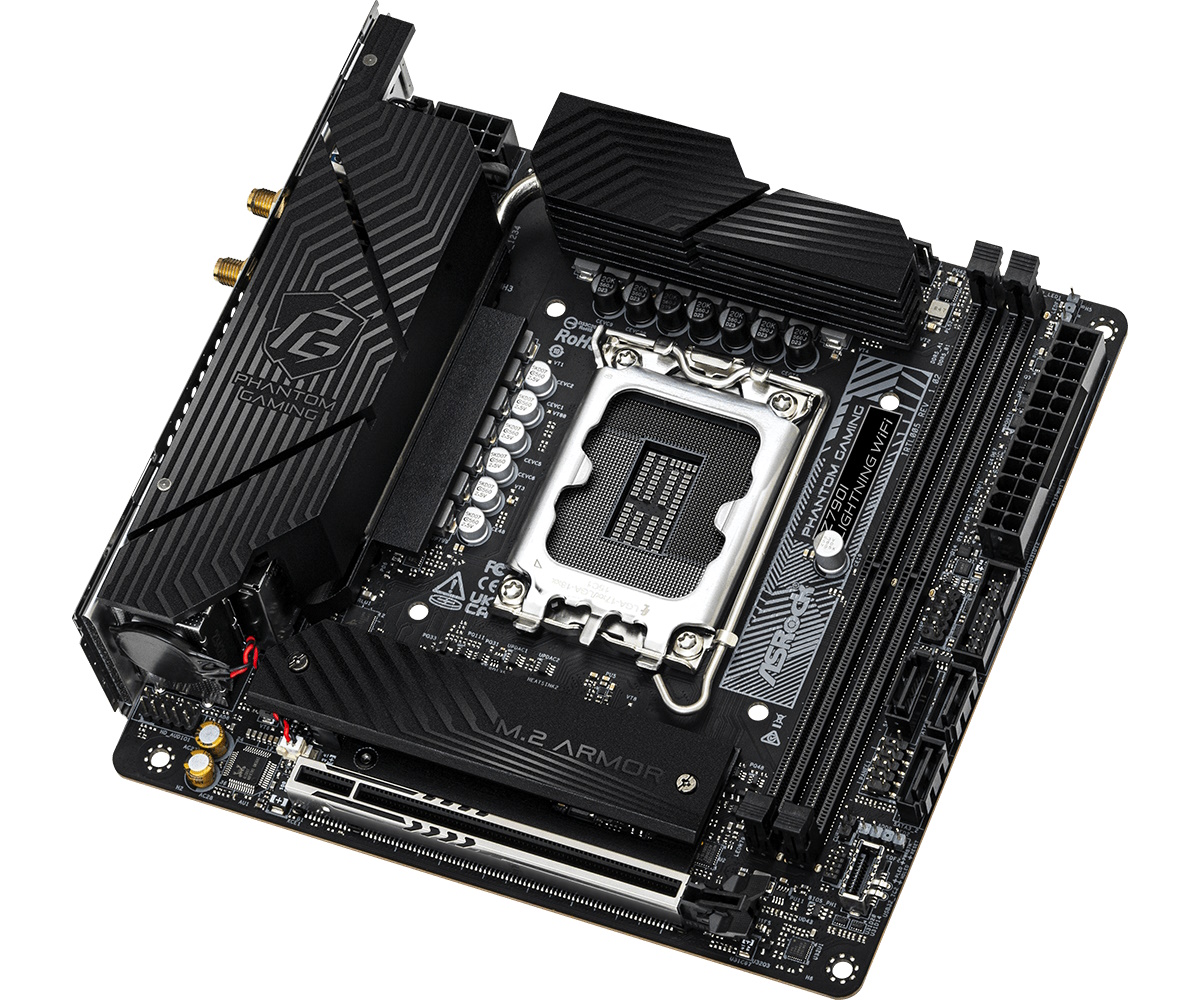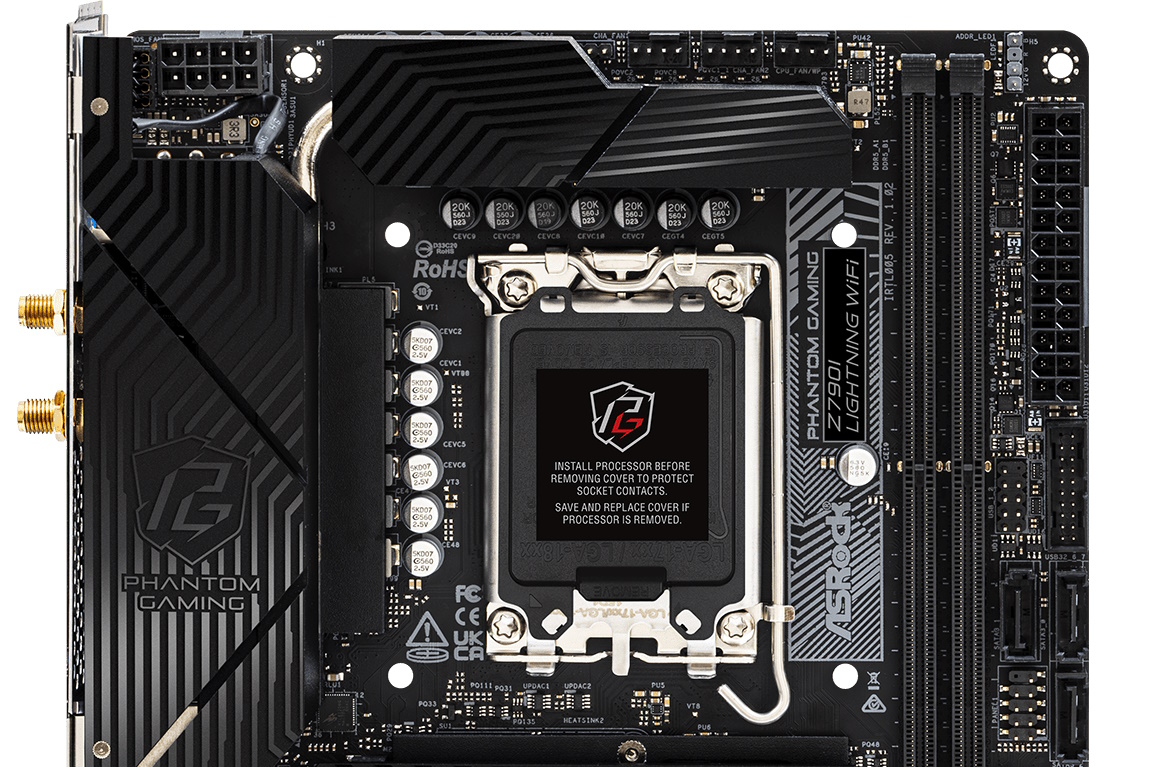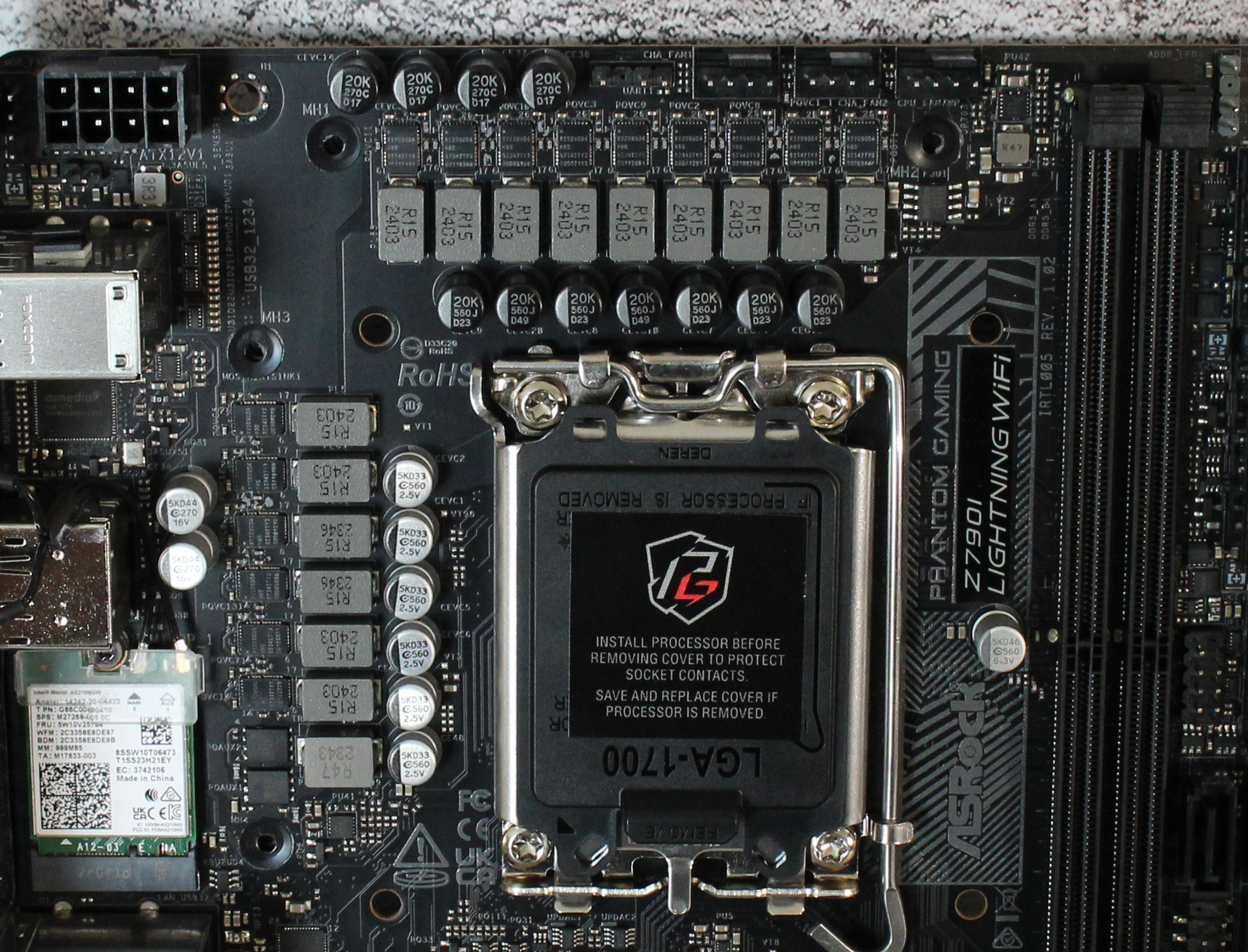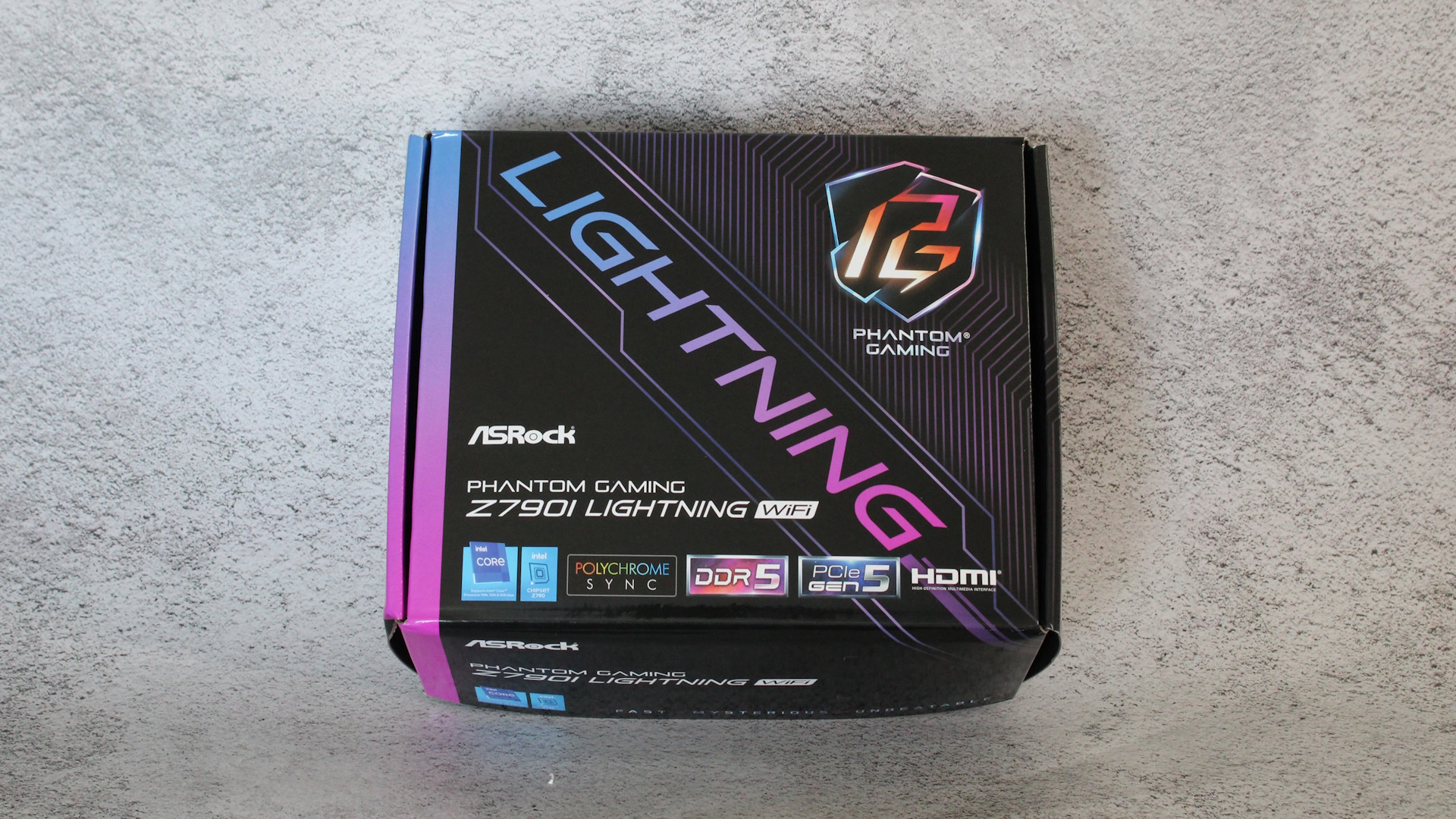Tom's Hardware Verdict
ASRock’s $280 Z790I Lightning Wi-Fi is a worthwhile lower-cost option for SFF Intel builds. You get enough storage options, fast networking, robust power delivery, and ultra-fast memory support. Just make sure you can live with just five USB Type-A ports on the rear IO and no PCIe 5.0-capable M.2 slot.
Pros
- +
Budget Z790 ITX pricing
- +
Powerful VRMs
- +
Ultra-fast memory support (DDR5-8600+)
Cons
- -
Only Five Type-A ports on rear IO
- -
Budget audio codec
- -
Lacks PCIe 5.0-capable M.2
Why you can trust Tom's Hardware
ASRock’s Z790I Lightning Wi-Fi is an affordable and powerful Mini-ITX motherboard. Built on the Z790 platform and a later arrival to the scene, it supports 12th, 13th, and 14th-generation processors out of the box. For under $280, you get most of what the platform offers. This includes a PCIe 5.0 x16 slot, two M.2 sockets (both PCIe 4.0), a budget audio codec, 2.5 GbE and Wi-Fi 6E Realtek, Intel-based networking, and an incredibly robust (for its size) power delivery. It’s a Mini-ITX board, so there isn’t much room to make it pretty, but the all-black, RGB-free design will undoubtedly blend in with most chassis and build themes.
ASRock’s Z790 lineup hasn’t changed drastically since the chipset’s release, but with several updates / refresh boards, the total is now up to 20. You’ll find all the standard sizes and wide-ranging prices, with familiar names like the Taichi, Steel Legend, Riptide, Pro, and the funky purple LiveMixer SKU. Prices range from $389.99 (Taichi Carrara - was $499.99) to the ASRock Z790M PG Lightning / D4 at $169.99 ($179.99 at launch). And let’s not forget its big brother, the PG-ITX/TB4 we reviewed and loved. The updated lineup has plenty of options for all sorts of users.
On the performance front, the Z790I Lightning was average to below average in most tests. None were exceedingly slow, and none led the pack. It did well in the Procyon Office and Video editing tests and was solid in gaming. We left the cooler type to “auto,” in the BIOS, and the processor can run at a constant 255W or until it thermally throttles. With our 3x140mm AIO, we didn’t see much throttling on this setting, even during stress tests. But, of course, your mileage may vary.
Below, we’ll dig into the details of the board and see whether it deserves a spot on our Best Motherboards list. Before we get into our testing and board specifics, though, we’ll start by listing the specifications from ASRock’s website.
Specifications: ASRock Z790I Lightning Wi-Fi
| Socket | LGA1700 |
| Chipset | Z790 |
| Form Factor | Mini-ITX |
| Voltage Regulator | 16-Phase (14x 110A SPS MOSFETs for Vcore) |
| Video Ports | (1) HDMI (v2.1) |
| Row 5 - Cell 0 | (1) DisplayPort (v1.4) |
| USB Ports | (1) USB 3.2 Gen 2, Type-C (10 Gbps) |
| Row 7 - Cell 0 | (1) USB 3.2 Gen 2 (10 Gbps) |
| Row 8 - Cell 0 | (4) USB 3.2 Gen 1 (5 Gbps) |
| Network Jacks | (1) 2.5 GbE |
| Audio Jacks | (2) Analog + SPDIF |
| Legacy Ports/Jacks | ✗ |
| Other Ports/Jack | ✗ |
| PCIe x16 | (1) v5.0 (x16) |
| PCIe x8 | ✗ |
| PCIe x4 | ✗ |
| PCIe x1 | ✗ |
| CrossFire/SLI | ✗ |
| DIMM Slots | (2) DDR5 8600+(OC)*, 96GB Capacity |
| Row 19 - Cell 0 | *1DPC 1R Up to 8600+ MHz (OC), 5600 MHz Natively. |
| Row 20 - Cell 0 | 1DPC 2R Up to 7000+ MHz (OC), 5200 MHz Natively. |
| M.2 Sockets | (2) PCIe 4.0 x4 (64 Gbps) / PCIe (up to 80mm) |
| Row 22 - Cell 0 | Supports RAID 0/1/5 |
| SATA Ports | (3) SATA3 6 Gbps (Supports RAID 0/1/5) |
| USB Headers | (1) USB v3.2 Gen 1, Type-C (5 Gbps) |
| Row 25 - Cell 0 | (1) USB v3.2 Gen 1 (5 Gbps) |
| Row 26 - Cell 0 | (1) USB v2.0 (480 Mbps) |
| Fan/Pump Headers | (3) 4-Pin (CPU, CPU/Water Pump, Chassis) |
| RGB Headers | (2) 3-pin ARGB |
| Diagnostics Panel | ✗ |
| Internal Button/Switch | ✗ |
| SATA Controllers | ✗ |
| Ethernet Controller(s) | (1) Realtek Dragon RTL8125BG (2.5 GbE) |
| Wi-Fi / Bluetooth | Intel AX210 Wi-Fi 6E (BT 5.3, 160 MHz, etc.) |
| USB Controllers | Asmedia ASM1074 |
| HD Audio Codec | Realtek ALC897 |
| DDL/DTS | ✗ / ✗ |
| Warranty | 3 Years |
Inside the Box of the ASRock Z790I Lightning Wi-Fi
Inside the retail packaging, below the motherboard, ASRock includes a few accessories to get you started. You get two SATA cables, a Wi-Fi antenna, screws for M.2 sockets, and a thermistor cable. There isn’t much here, which isn’t surprising at this price point, but it’s enough to cover the basics.
Design of the Lightning Wi-Fi



This little motherboard sits on a server-grade 8-layer matte black PCB. The sole design element comes from the actively cooled, heatpipe-connected VRM heatsinks and M.2 heatsinks. The heatsinks have lines that meander their way around the metal bits. On the left, you see the Phantom Gaming branding as well. If you’re interested in RGB lighting in your chassis, you’ll have to add your own to the onboard headers, as the board does not include any natively. The all-black appearance looks good and, in my opinion, better than the more expensive PG-ITX/TB4.

Starting in the left corner, we spy a single 8-pin EPS connector just above the heatpipe connecting the heatsinks. The VRMs have plenty of mass and surface area to keep the powerful VRMs below running cool. There’s also a small fan attached to the heatsink tucked in between the rear IO plate and the VRM for additional cooling. The default fan curve sounds improved from the PG-ITX/TB4. While it was still audible, we could hear it only during stress testing. Of course, you can adjust it if needed. Also by the EPS connector is the 2-pin temperature sensor header to use with the included thermistor.
Get Tom's Hardware's best news and in-depth reviews, straight to your inbox.
Across the top are four headers: one RGB, and three 4-pin fan headers. All fan headers support PWM- or DC-controlled devices. The chassis fan headers output up to 1A/12W while the CPU_FAN1/WP is up to 2A/24W. There’s not a lot of power to share, but it is a small motherboard that generally resides in small cases with fewer fans anyway. The RGB header to the right is 3-pin/ARGB (as is the other one). Control over the attached RGB devices is handled through ASRock’s Polychrome Sync application.
Continuing right, we run into the two DRAM slots, with locking mechanisms on both sides. ASRock lists capacity up to 96GB with speeds up to a mind-blowing DDR5-8600+(OC). In fact, world-class overclocker and Tom’s contributor, Splave, used the board to set multiple overclocking records. As always, your mileage may vary depending on the memory kit (stick to the QVL, especially for high speeds) and if your processor (specifically the memory controller) can handle the speed. This is only the second board that allowed my processor and our Klevv DDR5-8000 memory to work without tweaking. I just enabled XMP and it was stable enough for a 30-minute stress test. Impressive.
Moving down the right edge, we run into the 24-pin ATX power connector for the board. I’d love to see the new, smaller ATX12VO connector used on Mini-ITX SKUs. I’d also like to see a POST Status Checker (like on the PG-ITX/TB4), but it’s missing on this board. This means there’s no way to tell why the system hangs in POST, at least without finding and connecting an internal header speaker . Next is the front panel USB 2.0 header and a 19-pin USB 3.2 Gen 1 (5 Gbps) header.
Next are three vertically mounted SATA3 ports and the front panel header. Below is the second 3-pin ARGB header, the 2-pin reset CMOS header, and the final front panel USB header - in this case, a USB 3.2 Gen 2 (10 Gbps) Type-C. With only five USB Type-A ports on the rear IO, you may need all of these onboard headers.

Power delivery on the Z790I Lightning has 16 phases, with 14 dedicated to Vcore. Power heads from the 8-pin EPS connector onto a Renesas RAA229131 PWM controller. From there, it heads to the 14 110A Renesas RAA2209004 SPS MOSFETs. The 1,540A available is the most I recall seeing on an ITX board and will surely handle Intel’s flagship-class processors, even when overclocking with sub-ambient cooling.

We’ll continue our counterclockwise journey at the bottom of the board. Here, we see the only expansion slot: a full-length PCIe 5.0 x16 slot. The slot also supports PCIe riser cards to extend one x16 slot to two x8 slots if needed. Above that, under the heatsink, is the first M.2 socket (you’ll find the other on the back of the board). Each M.2 socket runs at PCIe 4.0 x4 (64 Gbps) speeds and supports up to 80mm modules. None of the sockets support SATA-based devices, but they support RAID0/1/10 modes, as do the SATA ports. Thankfully, There’s no lane / bandwidth sharing, and you can run all storage simultaneously without a performance penalty.
To the left of the PCIe slot is the Realtek ALC897 audio codec, along with a few dedicated audio capacitors. This solution is OK and should be fine for most users, but it is a budget option. You’ll also find the front panel audio header here.

The rear IO plate on the Z790I Lightning comes preinstalled on the motherboard. It has a black and gray background, the Phantom Gaming branding in the corner, and plenty of venting for the hidden VRM fan. In total, there are five USB Type-A ports (four are USB 3.2 Gen 1) while the other below the Realtek 2.5 GbE port is faster at USB 3.2 Gen 2 (10 Gbps) speeds. Additionally, you get a USB Type-C port with USB 3.2 Gen 2 (10 Gbps) speeds. There are DisplayPort and HDMI ports for video, while the Wi-Fi 6E antenna connections sit just above that. Last but not least, on the far right, is the audio stack with two 3.5mm jacks (mic in and line out) and the SPDIF output.
There’s nothing out of the ordinary here, though I would like to have seen a 3.2 Gen 2x2 (20 Gbps) port on this board and more Type-A ports, as five can be limiting.
MORE: Best Motherboards
MORE: How To Choose A Motherboard
MORE: All Motherboard Content

Joe Shields is a staff writer at Tom’s Hardware. He reviews motherboards and PC components.
